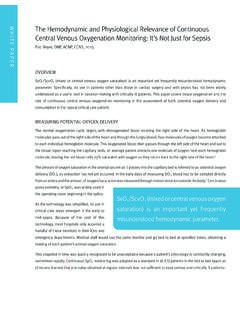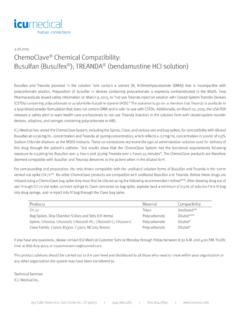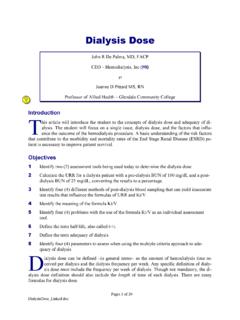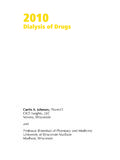Transcription of The Benefits of a Saline Flushing Protocol when using the ...
1 White PaPerThe Benefits of a Saline Flushing Protocol when using the Tego Needlefree hemodialysis Connector BACKGROUNDS tandard Protocol for dialysis patients that are completing the end of their treatment at a dialysis center is to receive a flush of their catheter with large concentrations of a Saline and heparin mixture to help prevent thrombotic occlusions. However, recent concerns and studies have shown that there are substantial risks associated with the use of heparin in these settings such as Heparin Induced Thrombocytopenia which may occur in as many as of In addition, safety alerts have been issued as far back as 2006 regarding fatal dosing errors involving In February 2008, a worldwide recall of heparin was initiated by its largest supplier, Baxter Healthcare, which resulted in global shortages.
2 Below is an excerpt from the February 11, 2008 United States Food and Drug Administration (FDA) statement regarding the Baxter REVIEWT hese recent concerns about the use and availability of heparin have caused facilities to evaluate its usage in the United States and abroad. The Tego needlefree hemodialysis connector was developed by ICU Medical specifically for use in hemodialysis , which requires unique engineering to support the high flow rates of blood and fluids. The Tego is a Neutral Displacement Connector, which means that when the blood tubing or a syringe is removed from the Tego there is minimal reflux of blood into the catheter lumen, thus reducing the need for heparin as an anticoagulant.
3 The Tego is also a microbiologically and mechanically closed connector that has been proven to reduce Catheter Related Bloodstream Infection (CRBSI) in pediatric hemodialysis Beta site studies have been performed using the Tego and Saline flush Protocol , which resulted in zero thrombotic occlusion events. Use of the Tego and Saline flush can drastically reduce manipulations of the catheter hub which are beneficial in reducing CRBSIs and thrombotic occlusions, and, in turn, improve patient REVIEWIn addition to improving patient outcomes, there are also substantial cost Benefits to using the Tego and a Saline flush.
4 A host of procedures and materials can be eliminated beyond the cost of the drug itself. Procedures such as thrice weekly Betadine soaks can be reduced to only one and associated materials can be eliminated. CRBSIs also carry significant costs to facilities, however, the cost to treat a CRBSI in a dialysis clinic may be considered cost neutral due to reimbursement practices. when a patient is hospitalized for a CRBSI, which may be as often as two weeks in a year, there is a significant loss of revenue for the clinic during this period.
5 As a supplement, a cost worksheet is available from ICU Medical to help demonstrate how the use of Tego and Saline flush can have cost Benefits in all 350 adverse events associated with the Baxter product have been reported since the end of last year compared to less than 100 reports in 2007. Most of the events have taken place at hemodialysis centers, almost exclusively involving patients receiving a bolus dose which is a high dose administered over a short time. While most of the reports involve multiple-dose vials, several cases include patients who received a bolus dose after their health care professional combined heparin from single-dose vials.
6 (FDA News; February 11, 2008).3 References1. Kadidal V, Heparin-Induced Thrombocytopenia (HIT) Due to Heparin Flushes. Internal Medicine. 1999:246, ISMP Safety ALERT: Complications Associated with Heparin Vials. 20-September, FDA NEWS, Baxter s Multiple-dose Vial Heparin Linked to Severe Allergic Reactions. February 11, McAfee N, Use of Tego Connector to Prevent hemodialysis Infections in Children. ADC, March 2008, Poster ReferencesFDA Guidance for Industry on General/Specific Intended Use, November 4, 1998. Section 513(i)(1)(F) Federal Food and Cosmetic Act (The Act).
7 510K 053106 Tego ConnectorM1-1302 Rev. 02 2012 ICU Medical using the Tego and a Saline flush, it is important that certain protocols are adhered to. To properly disinfect the Tego prior to access, an isopropyl alcohol swab using an aggressive circular motion for three seconds is required. The dialysis catheter must be also be properly flushed with normal Saline after each use. To reduce manipulations, it is very important to utilize a complete 10 mL or 20 mL Saline flush following the dialysis treatment. It is not appropriate to use two 5 mL syringes to achieve a 10 mL flush as this increases the number of manipulations and, therefore, risk of CRBSI and thrombotic occlusion.
8 The following points identify appropriate Protocol elements to include with the Tego and a Saline only flush. The following table represents a week-long Protocol for the dialysis patient. Day One:Day Three:Day Five:1. Aspirate 3-5 mL to clear lumens and SWAB SWAB Remove Tego Aspirate 3-5 mL to clear lumens and Aspirate 3-5 mL to clear lumens and Perform Betadine soak on catheter Perform pre-treatment flush to verify catheter Perform pre-treatment flush to verify catheter Apply new Tego to each SWAB SWAB SWAB Attach bloodlines and perform Attach bloodlines and perform Perform pre-treatment flush to verify catheter Remove Remove SWAB SWAB SWAB Attach bloodlines and perform Flush catheter
9 using 10 mL or 20 mL Flush catheter using 10 mL or 20 mL Remove SWAB Flush catheter using 10 mL or 20 mL By reducing manipulations at the catheter hub using a Tego needlefree hemodialysis connector, CRBSIs and thrombotic occlusions may be reduced or eliminated. Use of a Saline flush Protocol in conjunction with the Tego can also greatly reduce patient risks and reduce overall treatment time and costs. It is recommended that strict adherence to the disinfection and flush protocols be recognized to achieve optimal patient outcomes.















